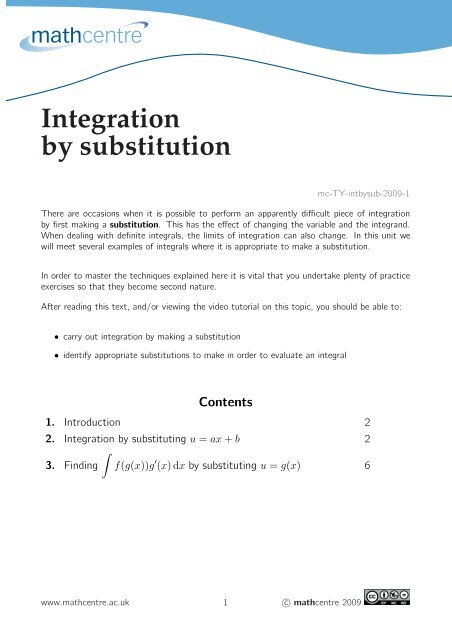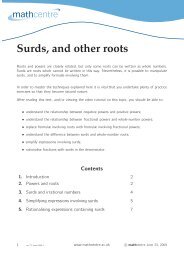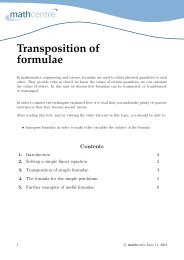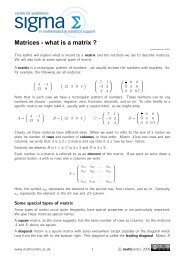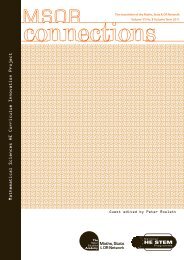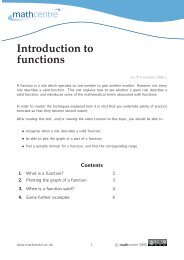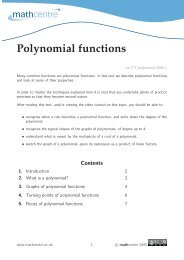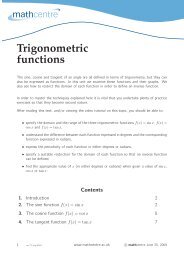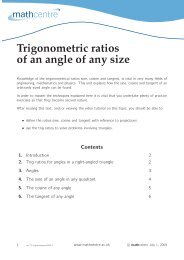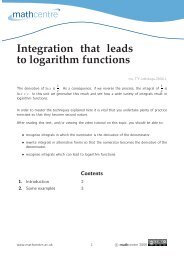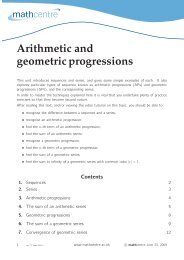Integration by substitution - Mathcentre
Integration by substitution - Mathcentre
Integration by substitution - Mathcentre
You also want an ePaper? Increase the reach of your titles
YUMPU automatically turns print PDFs into web optimized ePapers that Google loves.
<strong>Integration</strong><strong>by</strong> <strong>substitution</strong>mc-TY-int<strong>by</strong>sub-2009-1Thereareoccasionswhenitispossibletoperformanapparentlydifficultpieceofintegration<strong>by</strong>firstmakinga<strong>substitution</strong>. Thishastheeffectofchangingthevariableandtheintegrand.Whendealingwithdefiniteintegrals,thelimitsofintegrationcanalsochange. Inthisunitwewillmeetseveralexamplesofintegralswhereitisappropriatetomakea<strong>substitution</strong>.Inordertomasterthetechniquesexplainedhereitisvitalthatyouundertakeplentyofpracticeexercisessothattheybecomesecondnature.Afterreadingthistext,and/orviewingthevideotutorialonthistopic,youshouldbeableto:•carryoutintegration<strong>by</strong>makinga<strong>substitution</strong>•identifyappropriate<strong>substitution</strong>stomakeinordertoevaluateanintegralContents1. Introduction 22. <strong>Integration</strong><strong>by</strong>substituting u = ax + b 2∫3. Finding f(g(x))g ′ (x) dx<strong>by</strong>substituting u = g(x) 6www.mathcentre.ac.uk 1 c○mathcentre2009
1. IntroductionThereareoccasionswhenitispossibletoperformanapparentlydifficultpieceofintegration<strong>by</strong>firstmakinga<strong>substitution</strong>. Thishastheeffectofchangingthevariableandtheintegrand.Whendealingwithdefiniteintegrals,thelimitsofintegrationcanalsochange. Inthisunitwewillmeetseveralexamplesofthistype. Theabilitytocarryoutintegration<strong>by</strong><strong>substitution</strong>isaskillthatdevelopswithpracticeandexperience. Forthisreasonyoushouldcarryoutallofthepracticeexercises. Beawarethatsometimesanapparentlysensible<strong>substitution</strong>doesnotleadtoanintegralyouwillbeabletoevaluate. Youmustthenbepreparedtotryoutalternative<strong>substitution</strong>s.2. <strong>Integration</strong> <strong>by</strong> substituting u = ax + bWeintroducethetechniquethroughsomesimpleexamplesforwhichalinear<strong>substitution</strong>isappropriate.ExampleSupposewewanttofindtheintegral∫Youwillbefamiliaralreadywithfindingasimilarintegral∫(x + 4) 5 dx (1)u 5 duandknowthatthisintegralisequalto u6+ c,where cisaconstantofintegration.Thisisbecauseyouknowthattherulefor6integratingpowersofavariabletellsyoutoincreasethepower<strong>by</strong>1andthendivide<strong>by</strong>thenewpower.Intheintegralgiven<strong>by</strong>Equation(1)thereisstillapower5,buttheintegrandismorecomplicatedduetothepresenceoftheterm x + 4. Totacklethisproblemwemakea<strong>substitution</strong>. Welet u = x + 4. Thepointofdoingthisistochangetheintegrandintothemuchsimpler u 5 .However,wemusttakecaretosubstituteappropriatelyfortheterm dxtoo.Intermsofdifferentialswehavedu =( ) dudxdxNow,inthisexample,because u = x + 4itfollowsimmediatelythat du = 1andso du = dx.dxSo,substitutingbothfor x + 4andfor dxinEquation(1)wehave∫ ∫(x + 4) 5 dx = u 5 duTheresultingintegralcanbeevaluatedimmediatelytogive u66 +c.Wecanreverttoanexpressioninvolvingtheoriginalvariable x<strong>by</strong>recallingthat u = x + 4,giving∫(x + 4) 5 (x + 4)6dx = + c6Wehavecompletedtheintegration<strong>by</strong><strong>substitution</strong>.www.mathcentre.ac.uk 2 c○mathcentre2009
ExampleSupposenowwewishtofindtheintegral∫cos(3x + 4) dx (2)Observethatifwemakea<strong>substitution</strong> u = 3x + 4,theintegrandwillthencontainthemuchsimplerform cos uwhichwewillbeabletointegrate.Asbefore,andsoItfollowsthatdu =with u = 3x + 4du =( ) dudxdxand( ) dudx = 3 dxdxdudx = 3So,substituting ufor 3x + 4,andwith dx = 1 3 duinEquation(2)wehave∫cos(3x + 4) dx =∫ 13 cosudu= 1 3 sin u + cWecanreverttoanexpressioninvolvingtheoriginalvariable x<strong>by</strong>recallingthat u = 3x + 4,giving∫cos(3x + 4) dx = 1 sin(3x + 4) + c3Wehavecompletedtheintegration<strong>by</strong><strong>substitution</strong>.∫Itisveryeasytogeneralisetheresultofthepreviousexample.Ifwewanttofind cos(ax+b)dx,the<strong>substitution</strong> u = ax+bleadsto 1 ∫cosuduwhichequals 1 aa sin u+c,thatis 1 ∫a sin(ax+b)+c.Asimilarargument,whichyoushouldtry,showsthat sin(ax + b)dx = − 1 cos(ax + b) + c.a∫sin(ax + b)dx = − 1 ∫cos(ax + b) + caKey Pointcos(ax + b)dx = 1 sin(ax + b) + cawww.mathcentre.ac.uk 3 c○mathcentre2009
ExampleSupposewewishtofind∫11 − 2x dx.Wemakethe<strong>substitution</strong> u = 1 − 2xinordertosimplifytheintegrandto 1. Recallthattheuintegralof 1 withrespectto uisthenaturallogarithmof u, ln |u|.Asbefore,udu =( ) dudxdxandsoItfollowsthatwith u = 1 − 2xdu =and( ) dudx = −2 dxdxdudx = −2Theintegralbecomes∫ 1u(− 1 2 du )= − 1 2∫ 1u du= − 1 ln |u| + c2= − 1 ln |1 − 2x| + c2Theresultofthepreviousexamplecanbegeneralised: ifwewanttofind<strong>substitution</strong> u = ax + bleadsto 1 ∫ 1a u duwhichequals 1 ln |ax + b| + c.a∫1ax + b dx,theThismeans,forexample,thatwhenfacedwithanintegralsuchas13x + 7 dxwecanimmediatelywritedowntheansweras1 ln |3x + 7| + c.3∫∫Key Point1ax + b dx = 1 ln |ax + b| + cawww.mathcentre.ac.uk 4 c○mathcentre2009
Alittlemorecaremustbetakenwiththelimitsofintegrationwhendealingwithdefiniteintegrals.Considerthefollowingexample.ExampleSupposewewishtofind∫ 31(9 + x) 2 dxWemakethe<strong>substitution</strong> u = 9 + x.Asbefore,( ) dudu = dxdxandsoItfollowsthatTheintegralbecomeswith u = 9 + xdu =and( ) dudx = dxdx∫ x=3x=1u 2 dududx = 1wherewehaveexplicitlywrittenthevariableinthelimitsofintegrationtoemphasisethatthoselimitswereonthevariable xandnot u.Wecanwritetheseaslimitson uusingthe<strong>substitution</strong>u = 9 + x.Clearly,when x = 1, u = 10,andwhen x = 3, u = 12.Sowerequire∫ u=12u=10u 2 du =[ 13 u3 ] 1210= 1 (12 3 − 10 3)3= 7283Notethatinthisexamplethereisnoneedtoconverttheanswergivenintermsof ubackintooneintermsof xbecausewehadalreadyconvertedthelimitson xintolimitson u.Exercises1.1.Ineachcaseusea<strong>substitution</strong>tofindtheintegral:∫∫ 1∫(a) (x − 2) 3 dx (b) (x + 5) 4 dx (c) (2x − 1) 7 dx (d)02.Ineachcaseusea<strong>substitution</strong>tofindtheintegral:∫∫ ∫ π/2(a) sin(7x − 3)dx (b) e 3x−2 dx (c) cos(1 − x)dx0∫ 1−1∫(d)(1 − x) 3 dx.17x + 5 dx.www.mathcentre.ac.uk 5 c○mathcentre2009
∫3. Findingf(g(x))g ′ (x) dx <strong>by</strong> substituting u = g(x)ExampleSupposenowwewishtofindtheintegral∫2x √ 1 + x 2 dx (3)Inthisexamplewemakethe<strong>substitution</strong> u = 1 + x 2 ,inordertosimplifythesquare-rootterm.Weshallseethattherestoftheintegrand, 2x dx,willbetakencareofautomaticallyinthe<strong>substitution</strong>process,andthatthisisbecause 2xisthederivativeofthatpartoftheintegrandusedinthe<strong>substitution</strong>,i.e. 1 + x 2 .Asbefore,andsoItfollowsthatdu =with u = 1 + x 2du =( ) dudxdxand( ) dudx = 2x dxdxdudx = 2xSo,substituting ufor 1 + x 2 ,andwith 2x dx = duinEquation(3)wehave∫2x √ 1 + x 2 dx ==∫ √u du∫u 1/2 du= 2 3 u3/2 + cWecanreverttoanexpressioninvolvingtheoriginalvariable x<strong>by</strong>recallingthat u = 1 + x 2 ,giving∫2x √ 1 + x 2 dx = 2 3 (1 + x2 ) 3/2 + cWehavecompletedtheintegration<strong>by</strong><strong>substitution</strong>.Letusanalysethisexamplealittlefurther<strong>by</strong>comparingtheintegrandwiththegeneralcasef(g(x)) g ′ (x).Supposewewriteg(x) = 1 + x 2and f(u) = √ uThenwenotethatthecomposition 1 ofthefunctions fand gis f(g(x)) = √ 1 + x 2 .1 whenfindingthecompositionoffunctions fand gitistheoutputfrom gwhichisusedasinputto f,resultingin f(g(x))www.mathcentre.ac.uk 6 c○mathcentre2009
Further,wenotethatif g(x) = 1 + x 2 then g ′ (x) = 2x.Sotheintegral∫2x √ ∫1 + x 2 dx isoftheform f(g(x)) g ′ (x) dxToperformtheintegrationweusedthe<strong>substitution</strong> ( u = ) 1 + x 2 . Inthegeneralcaseitwillbeduappropriatetotrysubstituting u = g(x).Then du = dx = g ′ (x)dx.dx∫ √uOncethe<strong>substitution</strong>wasmadetheresultingintegralbecame du. Inthegeneralcaseit∫willbecome f(u) du.Providedthatthisfinalintegralcanbefoundtheproblemissolved.Forpurposesofcomparisonthespecificexampleandthegeneralcasearepresentedside-<strong>by</strong>-side:∫2x √ ∫1 + x 2 dxf(g(x))g ′ (x)dx∫let u = 1 + x 2 let u = g(x)( )( )dududu = dx = 2x dx du = dx = g ′ (x) dxdxdx2x √ ∫ ∫∫√u1 + x 2 dx = du f(g(x))g ′ (x)dx = f(u) du23 u3/2 + c23 (1 + x2 ) 3/2 + cToevaluate∫Key Pointf(g(x))g ′ (x)dxsubstitute u = g(x),and du = g ′ (x)dxtogive∫f(u) du<strong>Integration</strong>isthencarriedoutwithrespectto u,beforerevertingtotheoriginalvariable x.Itisworthpointingoutthatintegration<strong>by</strong><strong>substitution</strong>issomethingofanart-andyourskillatdoingitwillimprovewithpractice. Furthermore,a<strong>substitution</strong>whichatfirstsightmightseemsensible,canleadnowhere. Forexample,ifyouweretrytofind ∫ √ 1 + x 2 dx<strong>by</strong>lettingu = 1 + x 2 youwouldfindyourselfupablindalley. Bepreparedtopersevereandtrydifferentapproaches.www.mathcentre.ac.uk 7 c○mathcentre2009
ExampleSupposewewishtoevaluateBywritingtheintegrandasf(u) = 1 √ u, g(x) = 2x 2 + 1and g ′ (x) = 4x.∫4x√2x2 + 1 dx∫1√2x2 + 1 ·4xwenotethatittakestheformf(g(x))g ′ (x)dxwhereThe<strong>substitution</strong> u = g(x) = 2x 2 + 1transformstheintegralto∫ ∫1f(u) du = √ du uThisisevaluatedtogive∫1√ udu =∫u −1/2 du= 2u 1/2 + cFinally,using u = 2x 2 + 1toreverttotheoriginalvariablegives∫4x√2x2 + 1 dx = 2(2x2 + 1) 1/2 + corequivalentlyExampleSupposewewishtofind∫ sin√ x√ xdx.2 √ 2x 2 + 1 + cConsiderthe<strong>substitution</strong> u = √ x.Thendu =( ) dudxdxsothat= 1 2 x−1/2 dx==12x 1/2dx12 √ x dx∫ √ ∫sin x√ dx = 2 xsin u dufromwhich∫2sin u du = −2 cosu + c= −2 cos √ x + cWecanalsomakethefollowingobservations:theintegrandcanbewrittenintheform sin √ x ·1√ x.www.mathcentre.ac.uk 8 c○mathcentre2009
Writing f(u) = sin uand g(x) = √ xthen g ′ (x) = 1 2 x−1/2 = 12x 1/2 = 12 √ x .Further, f(g(x)) = sin √ x.Hencewewritethegivenintegralas∫2sin √ x 12 √ x dxwhichisoftheform∫2f(g(x))g ′ (x) dxwith fand gasgivenabove.Asbeforethe<strong>substitution</strong> u = g(x) = √ xproducestheintegral∫ ∫2 f(u) du = 2 sin u dufromwhich∫2sin u du = −2 cosu + c= −2 cos √ x + cExercises21.Ineachcasetheintegrandcanbewrittenas f(g(x)) g ′ (x).Identifythefunctions fand gandusethegeneralresultonpage7tocompletetheintegration.∫∫∫(a) 2xe x2−5 dx (b) −2x sin(1 − x 2 cos x)dx (c)1 + sin x dx.2.Ineachcaseusethegiven<strong>substitution</strong>tofindtheintegral:∫(a) −2xe −x2 dx, u = −x 2 .∫(b) x sin(2x 2 )dx, u = 2x 2 .(c)∫ 50x 3√ x 4 + 1dx, u = x 4 + 1.3.Ineachcaseuseasuitable<strong>substitution</strong>tofindtheintegral.∫(a) 5x √ ∫∫dx1 − x 2 dx (b) √ √ (c) x 4 (1 + x 5 ) 3 dxx(1 + x)2∫x 3∫∫(d) √x4 + 16 dx (e) cosx1x 3(f) √(5 + sin x) 2 0 x4 + 12 dx∫(g) 5x 2√ ∫∫1 − x 3 dx (h) e cos x sin x dx (i) e sin x cosxdx.www.mathcentre.ac.uk 9 c○mathcentre2009
AnswerstoExercisesExercises1(x − 2) 4 46511. (a) + c (b) = 930 1 45 5(2x − 1) 8(c) + c (d) 4.16cos(7x − 3)2.(a) − + c (b) e3x−2+ c (c)1.382(3dp) (d) 1 ln |7x + 5| + c737Exercises21. (a) f(u) = e u , g(x) = x 2 − 5, e x2−5 + c,(b) f(u) = sin u, g(x) = 1 − x 2 , − cos(1 − x 2 ) + c(c) f(u) = 1 , g(x) = 1 + sin x, ln |1 + sin x| + c.u2. (a) e −x2 +c (b) − cos(2x2 )+ c (c) 2610(4sf).43. (a) − 5 3 (1 − x2 ) 3/2 + c (b) − 21 + √ x + c (c) 120 (1 + x5 ) 4 + c1(d)2 (x4 + 16) 1/2 1+ c (e) − + c (f) 0.07075 + sin x(g) − 10 9 (1 − x3 ) 3/2 + c (h) −e cos x + c (i) e sin x + c.www.mathcentre.ac.uk 10 c○mathcentre2009


